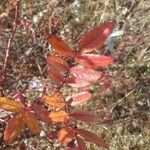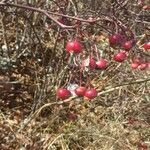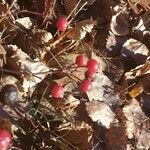Shrubs or subshrubs, forming scattered populations. Stems spreading and weak, sometimes erect, slender, 3–10(–13) dm, openly branched; bark dull reddish brown, glabrous; infrastipular prickles usually paired, erect, sometimes declined, rarely curved, flat, subulate, (2–)3–9 × 1.5–3 mm, ?base glabrous?, internodal prickles sparsely or densely mixed with aciculi, stipitate glands and smaller internodal prickles. Leaves 5–10(–16) cm; stipules 10–18(–23) × 2–3 mm, auricles flared, 2–4 mm, margins entire or subserrate, eglandular or finely stipitate-glandular, surfaces glabrous, rarely puberulent, eglandular; petiole and rachis sometimes with pricklets ?3 mm?, aciculi few, glabrous, rarely pubescent, rarely stipitate-glandular; leaflets (3–)5–7(–9), terminal: petiolule 4–11 mm, blade ovate, elliptic, or lanceolate, 18–50 × 9–28 mm, membranous, base cuneate, margins 1–2+-serrate, teeth 8–14(–18) per side, eglandular or gland-tipped, apex acute to acuminate, rarely obtuse, abaxial surfaces pale green, glabrous, rarely pubescent, eglandular or glandular, adaxial usually green, dull, rarely slightly lustrous, glabrous. Inflorescences corymbs, 1–3(–6)-flowered. Pedicels erect, slender, 5–19 mm, glabrous, sparsely to ± densely stipitate-glandular, sometimes eglandular; bracts 2, lanceolate, 10–17 × 2–4 mm, margins entire, usually eglandular, surfaces with sparse hairs, stipitate-glandular. Flowers 3–5.5 cm diam.; hypanthium globose or ovoid, 4–6(–8) × 3.5–5(–8) mm, glabrous, ± densely to sparsely stipitate-glandular, sometimes eglandular, neck (0–)0.5–1 × 2 mm; sepals reflexed, sometimes spreading, lanceolate, 10–22 × 2–3 mm, tip 2–10 × 0.5–1 mm, margins pinnatifid or entire, abaxial surfaces rarely puberulent, stipitate-glandular, rarely eglandular; petals single, pink, 15–24 × 13–19 mm; ?stamens 105?; carpels 32–46, styles exsert 1 mm beyond stylar orifice (1.5–2 mm diam.) of hypanthial disc (4–5 mm diam.). Hips red or orange-red, globose or depressed-globose, rarely ellipsoid, 7–14 × 6–15 mm, fleshy, glabrous, densely to sparsely stipitate-glandular, sometimes eglandular, neck 0–0.5 × 5–6 mm; sepals early deciduous, spreading to reflexed. Achenes basal, 2–6(–10), tan, 4–5 × 2.5–3 mm.
More
Colonial; stems simple or little-branched, rarely over 1 m, usually copiously armed with internodal prickles, these all about alike in form, but variable in size, straight, slender, and terete to the base, which is mostly less than half as long as the body; infrastipular prickles scarcely differentiated; stipules glandular-dentate to entire; lfls 3–7, oblong to oval or subrotund, often more than half as wide as long, coarsely toothed, in some forms glandular on the margin; fls usually borne singly on stems of the season; pedicel and hypanthium stipitate-glandular; sep attenuate into a linear tip, or rarely with a narrow foliaceous appendage, soon spreading or reflexed, then deciduous; pet pink, 2–3 cm; hips red, 8–12 mm thick; 2n=28. Uplands woods, dunes, and prairies; Me. to Minn., s. to Fla. and Tex. (R. housei; R. humilis; R. lyonii; R. obovata) Hybridizes extensively with R. arkansana (forming R. ×rudiuscula), and R. virginiana, and perhaps less often with R. acicularis and R. palustris.
A low shrub. It grows 1-1.5 m high. The branches are slender and arch over. They have stiff hairs and curving spines. The leaves are compound with 3-9 leaflets. They are alternate and fall off during the year. Each leaflet is widest near the middle. They are 2-4 cm long. They are pointed at the tip and have teeth along the edge. The flowers occur singly. They have 5 pink petals. The fruit are round and red and fleshy. They are 5-10 mm across. They contain several small seeds.
Pastures, woodlands, glades, openings in woodlands, dry forests and woodlands, roadsides, stream banks, rocky ravines, ledges, bluffs, power line rights-of-way; at elevations up to 1,100 metres
More
It is a temperate plant. It grows in open woodlands and on the edge of fields. It suits hardiness zones 4-8.



